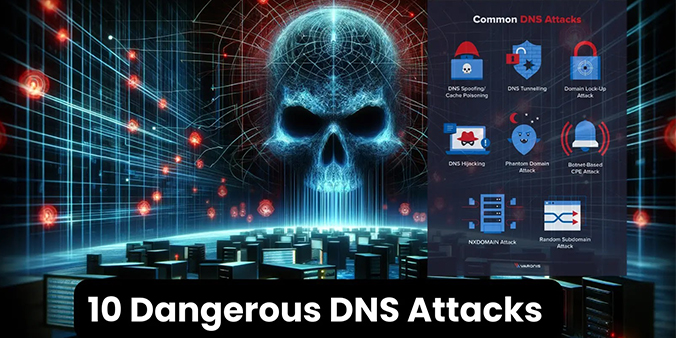This blog post focuses on proactive cyber defense mechanisms for the top 10 DNS attacks in 2024. It will go through each type of attack and provide their prevention methods. Since DNS is a vital component of the internet and is constantly being targeted, there's a great requirement for constant monitoring. DNS is highly vulnerable since it runs on UDP and occasionally TCP, especially when used as a DDoS weapon. DNS is an appealing target since it converts familiar names into crucial numerical data.
As per IDC data, the average DNS mugging expenditure increased by 49 percent when compared to the previous year. Nevertheless, the average cost of a DNS attack in the United States is higher than $1.27 million. Nearly 48% of US businesses claim to have lost more than $5 million on each break, while over 10% claim to have blown more than $500,000 on a DNS attack. To elaborate, the majority of US-based companies claim that it took them more than a day to identify a DNS attack.
Therefore, this blog post has been prepared to list the top 10 DNS attacks across the world. In addition, it also explains the appropriate prevention methods, making it simple for individuals & businesses to identify the DNS threats and take quick action.
What are DNS Attacks?
There are various ways in which a DNS (Domain Name System) attack can be displayed. Several methods exist for hackers to take advantage of DNS vulnerabilities. Most of these attacks try to exploit vulnerabilities in the DNS (Domain Name System) to prevent people from visiting particular websites.
These occurrences fall under the wide category of DoS (Denial-of-Service) attacks. DNS hijacking is a tactic that reroutes people to malicious websites by taking advantage of DNS flaws. Hackers can use methods such as DNS tunneling to circumvent organizations and send data outside of them in secret.
10 Most Dangerous DNS Attacks and Their Countermeasures
Discover the battlefield of the internet as we expose the ten most dangerous DNS attacks, exposing their dangers and offering workable defenses.
DNS Cache Poisoning Attack
Cache poisoning is one of the most common attacks on the web and is designed to trick users into visiting fraudulent sites when they visit legitimate ones, such as when someone visits gmail.com to check their email. Additionally, the DNS is corroding, resulting in the display of a scam website instead of the gmail.com page, for example, to regain access to the victim’s email account.
Therefore, users who type in the proper domain name will be tricked into visiting a fraudulent website. The severity of the attack and the damage done by DNS poisoning depends on several variables. Simply put, it creates a fantastic opportunity for hackers to utilize phishing techniques to steal personal or financial information from naive victims.
How to Prevent a “DNS Cache Poisoning Attack”?
Cleaning out DNS caches regularly is the easiest method to stop DNS cache poisoning. Waiting for the cache to empty itself can expose thousands of users to danger and allow a poisoned cache to linger for weeks if you are a DNS server administrator.
You should use caution even if you have a private DNS server. While keeping an eye on server speed and potential signs of compromise will also be beneficial, routinely clearing the cache is the most reliable approach to reducing the risk of IP address poisoning.
Distributed Reflection Denial of Service
Distributed reflective denial of service (DRDoS) attacks aim to overwhelm a target with so many UDP acknowledgments that they cause the target to go down. In certain instances, attackers have been known to relocate DNS, NTP, and other records. To give more recognition to the host that runs at the fictitious address, they need a spoof source IP. Since UDP doesn't establish a connection state, it is the protocol of choice for several defenses against this kind of attack.
For this argument, let's assume that an IP address spoofing attack caused a TCP connection to end as soon as the SYN/ACK packet vanished. The target disappears when these reaction packs begin to appear. The idea of collective reflection emerges when these attacks are managed at an appropriate size; several endpoints broadcast fictitious UDP offers, producing acknowledgments that are aimed at a single target.
How to Prevent “Distributed Reflection Denial of Service”?
To avoid giving a hacker a single deep target, you can disperse organizational assets by following these procedures.
- Locate servers in various data centers first.
- Make sure different networks are connected to your data centers.
- Ensure several pathways are available in data centers.
- Ensure that there are no critical security flaws or single points of failure in the data centers or the networks they are connected to.
Making sure that devices are dispersed regionally and not centralized in one data center is crucial for any business that depends on servers and Internet ports.
DNS Hijacking
Through a method called "DNS hijacking," someone can be sent to an unreliable DNS. To accomplish this, though, you might need to deploy illicit server changes or malicious malware. Meanwhile, the individual in charge of the DNS can point anyone who manages it to a website that appears the same but offers more content, like advertisements. Additionally, they could point users to dangerous websites or different search engines.
How to Prevent “DNS Hijacking”?
Since a DNS name server can be taken over and exploited by several hackers to launch denial-of-service attacks on other people, it is a sensitive foundation that requires the appropriate security measures. For this reason, we have discussed some ways to avoid DNS hijacking below.
- Search your network for resolvers.
- Limit a name server's accessibility severely.
- Implement countermeasures for cache poisoning.
- Patch known vulnerabilities right away.
- Keep the resolver and authoritative name server apart.
- Limit changes to the zone.
Phantom Domain Attack
Attacks coming from a casual subdomain are comparable to those coming from a phantom domain. This kind of attack overloads your DNS resolver with resources as it searches for these "phantom" domains, which never reply to DNS queries. This attack aims to make the DNS resolver server wait unnecessarily long before giving up or responding slowly, both of which are detrimental to DNS performance.
How to Prevent “Phantom Domain Attack”?
You can examine your log messages to detect phantom domain attacks. Additionally, you can lessen this attack by taking the actions we've listed below.
- First, add more recursive clients to the mix.
- To achieve the best outcomes, arrange the following parameters in the correct order.
- Limit the number of recursive searches that can be made in every zone and server.
- Give the ability to pause for unresponsive servers and verify recursive queries for each zone.
The failure values are set at an excellent level for overall operations when you approve any of the options.
DNS Flood Attack
A Distributed Denial of Service (DDoS) attack on your DNS system is one of the most frequent types of DNS attacks. Because every handled DNS zone has an impact on resource records, the primary objective of this type of DNS flood is to overwhelm your server to the point where it is unable to process any more DNS requests.
This kind of attack is easy to mitigate because it often comes from a single IP. But things could get complicated when hundreds or thousands of people participate in a DDoS. The mitigation strategy can be challenging at times because a lot of requests will be legitimately sent to confuse defense equipment, and a lot of them will be promptly recognized as malicious defects.
How to Prevent “DNS Flood Attack”?
Attacks known as distributed denial of service (DDoS) have started to target the Domain Name System (DNS). When a Distributed Denial of Service (DDoS) flood attack targets a DNS, any domain information stored in that DNS becomes unavailable.
As a result, we've created a defense against these assaults that includes monitoring the most frequently queried domain names across numerous DNS providers and regularly updating outdated data. Thus, even in the most extreme DNS Flood assault scenarios, our method can process more than 70% of all cache replies, according to the results of our simulations.
Random Subdomain Attack
Although it's not the most frequent type of DNS attack, it occasionally happens on various networks. Random subdomain attacks are frequently classified as DoS attacks since their creation serves the same objective as simple DoS attacks. We've covered you in case spoilers start sending DNS requests to a completely good and working domain. However, several dead subdomains will be the subject of the inquiry rather than the primary domain name.
This attack intends to produce a denial-of-service (DoS) that will overload the official DNS server in charge of managing the primary domain name, hence blocking the execution of any DNS record lookups. This is an attack that is hard to pinpoint because the searches will come from infected individuals who are not aware they are sending specific kinds of queries from what are ultimately real PCs.
How to Prevent “Random Subdomain Attack”?
We have given you a quick and easy way to stop the random subdomain attack within 30 minutes.
- Initially, you need to become proficient in mitigating attacks that cause excessive traffic on resolvers and online resources associated with the victim's names that are subject to removal.
- Next, learn about contemporary features that protect DNS professionals from attacks, such as Response Rate Limiting.
Botnet-based Attacks
More precisely, a botnet is an assembly of compromised devices connected to the Internet that can be used to initiate a coordinated denial-of-service attack. In the course of the attack, the compromised devices can be used to send spam, steal data, and give the attacker complete control over the device and its network connection.
Furthermore, botnets are dynamic threats; the more we rely on digital devices, the internet, and future technological advancements, the more sophisticated these attacks will become. Given that botnets can be viewed as both programs for future attacks and as a form of attack, this study explores the structure, description, and application of botnets.
How to Prevent “Botnet-Based Attacks”?
This is one of the many DNS attacks that victims encounter daily; therefore, to help you counteract these attacks, we have included a few methods below.
- First, accurately assess your vulnerabilities.
- This is among several DNS attacks that victims encounter daily.
- Therefore, to help you counteract these attacks, we have included a few methods below.
- First, accurately assess your vulnerabilities.
- Next, provide the IoT devices security.
- Determine the facts behind both of your mitigating myths.
- Find, categorize, and exert control.
Domain Hijacking
To divert your traffic, the attacker in this type of attack alters the DNS servers and domain registrar. A security flaw in a domain registrar's system is often the main cause of domain hijacking, however, if an attacker manages to obtain access to your DNS data, domain hijacking can happen at the DNS level as well.
Thus, if a hacker gains possession of your domain name, they can utilize it for other malicious activities, such as creating a fake website for payment processors like PayPal, Visa, or bank systems. Attackers will build a phony website that mimics the real one to obtain private data, such as passwords and email addresses.
How to Prevent “Domain Hijacking”?
Thus, by putting a few of the measures we've listed below into practice, you can easily reduce domain hijacking.
- Upgrade your DNS in the application foundation.
- Use DNSSEC.
- Secure access.
- Client lock.
DNS Tunneling
This hack transmits encoded data from many apps by using the DNS acknowledgment and query channels. This technology was never meant to be used widely, but because it can get over-interface security measures, it is now frequently used in attacks. To do DNS tunneling, an attacker has to have physical access to the target system, a domain name, and a DNS authoritative server.
How to Prevent “DNS Tunneling”?
We've covered three techniques to mitigate these kinds of attacks: setting up an application rule that uses some protocol object to identify and block DNS tunneling on the firewall.
- Create an access rule.
- Create a protocol object.
- Create an application rule.
TCP SYN Floods
A SYN Flood is a straightforward Denial-of-Service (DDoS) attack that can interfere with any service that communicates over the internet using the Transmission Control Protocol (TCP). SYN waves, a type of TCP State-Exhaustion attack, can target common infrastructure components such as load balancers, firewalls, Intrusion Prevention Systems (IPS), and utilization servers. The attack aims to take advantage of the connection element tables present in these components.
Therefore, this type of attack can bring down even high-capacity equipment that is meant to handle millions of links. Furthermore, a TCP SYN flood attack occurs when a hacker overwhelms a system with SYN requests in an attempt to bring it down and prevent it from responding to fresh, legitimate connection offers. It thus encourages a state where all information ports on the target server are only partially open.
How to Prevent “TCP SYN Floods”?
Although vital, intrusion prevention systems (IPS) and firewalls alone cannot stop sophisticated DDoS attacks. Because assaults are becoming more sophisticated, a comprehensive approach that goes beyond simple network maintenance and internet access is required. Therefore, you may rely on certain features for faster mitigation of TCP SYN flood attacks and more potent DDoS protection.
- To prevent the network from having a single point of failure, first support both inline and out-of-band deployment properly.
- Wide network separation with the ability to view and analyze traffic from different network segments.
- Fast and accurate detection is ensured by a variety of threat intelligence sources, such as fingerprints of known threats, statistical exception detection, and customized entrance alerts.
- Adaptable to manage attacks of all kinds, ranging from high-end to low-end and vice versa.
A Final Note
As you can see, DNS service is critical to maintaining the daily operation of your businesses websites and online support. So, this essay will be useful to you if you're seeking ways to avoid these kinds of DNS attacks.




